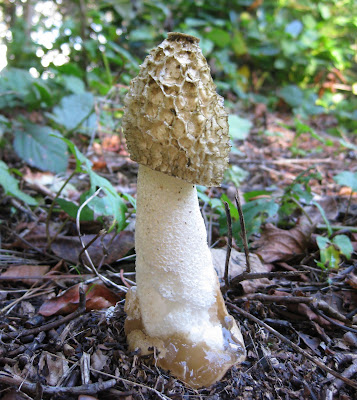The above pic shows how it looked 24 hours after emerging from the initial egg-like structure (below). I'd read how quickly they grow, so returned the next day to check on its progress. Surprisingly it had grown to full size and the insects of the manor had busily removed all of the spores, quick work!
The fruitbody begins as an egg-like structure from which the stalk grows rapidly, the stalk tip is covered in a stinky slimy spore mass known as the gleba. This thoroughly malodorous slime is what attracts the flies, who ingest and cover themselves in the substance to deposit the spores elsewhere. The fungi examples I found the slime has already been removed revealing the pale off-white honeycombed top.
Here's the spot where I found it, in a cleared verge in dappled shade amongst rhododendrons. Unfortunately I managed to crack my head on the diagonal branch which wasn't quite what I had in mind for a lunchtime fungi foray but luckily I have a resonably dense head so no damage was incurred.
Here are two more spotted in the vicinity earlier in the week, with a minimum of spores still visible.




Never seen one in complete form. Great set of pics Linda.
ReplyDeleteA cracking post which you could have labelled "What a stonker" also. A great set of images.
ReplyDeleteOne thing though, WAS THE TREE O.K. ?
John
Hey CB, thanking you. It really was a stinker.
ReplyDeleteHello Johnny, charming! After calling in the expertise of a tree surgeon I was assured that damage was minimal so no treetment required. Tree-hee!
Hi Linda, and thanks for your kind comment. This piece is very interesting as I went out on Tuesday looking for fungi and found a couple which I'm certain are Stinkhorns but which must be well passed their best. They certainly didn't have the 'head' as yours do but the body is very sponge-like as in your last picture. I really do like your new template - is it one of the new ones available?
ReplyDelete